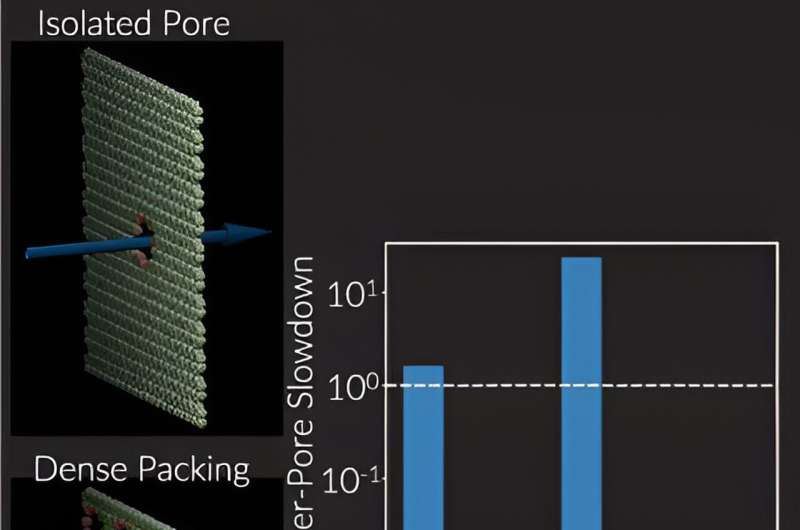
Nanoporous membranes have been shown to be valuable tools for filtering out impurities from water and numerous other applications. However, there’s still much work to be done in perfecting their designs. Recently, the lab of Prof. Amir Haji-Akbari has demonstrated that exactly where the nanosized holes are placed on the membrane can make a big difference. The results are published in ACS Nano.
In recent years, nanoporous membranes made from graphene, polymers, silicon and other materials have been used successfully for separating gas, desalinating water, virus filtration, power generation, gas storage, and drug delivery. However, creating membranes that let all the right molecules pass through while keeping the undesired ones out has proven tricky.
For desalinating water, for instance, it’s crucial that the membrane has a high permeability for water while sufficiently blocking small ionic and molecular solutes, and other impurities. But researchers have found that enhancing the permeability of a membrane often compromises its selectivity, and vice versa.
One promising approach is to optimize the chemistry and geometry of isolated nanopores to achieve the desired permeability and selectivity, and place as many of those pores as possible within a nanoporous membrane. Exactly how neighboring pores affect each other, though, is unclear.
At the nanoscale, molecules interacting with pore walls can exhibit behaviors that defy conventional theories. The Haji-Akbari lab explored whether they could design innovative membrane systems with increased precision and efficiency by fine-tuning the nanopores.
With computer simulations, Haji-Akbari’s research team found that nanoscale proximity between pores can detrimentally affect water permeability and salt rejection. Specifically, they created simulations of membranes with varying patterns of pore placement, including a hexagonal lattice and a honeycomb lattice. What they found was that the hexagonal pattern, which allowed for more distance between pores, had a greater permeability/selectivity performance than the membrane with the honeycomb pattern.
These effects deviate from established theories, Haji-Akbari said.
“This assumption that the pore resistance is independent of the proximity of the pore is not correct,” said Haji-Akbari, assistant professor of chemical & environmental engineering. “Clearly, it depends on proximity.”
Their findings shed insight on how these effects accelerate the movements of certain ions through membranes while causing other ions to decelerate. Further, it can inform better designs of nanoporous membranes for enhanced separation processes such as water desalination and other applications.
More information:
Brian A. Shoemaker et al, Correlations in Charged Multipore Systems: Implications for Enhancing Selectivity and Permeability in Nanoporous Membranes, ACS Nano (2024). DOI: 10.1021/acsnano.3c07489
Journal information:ACS Nano
Provided by
Yale University

READ MORE
Putting a new spin on 1T phase tantalum disulfide: Scientists uncover a hidden electronic state
Evolution with temperature of polarons in tantalum layers of 1T-TaS2 through different CDW phases: commensurate [...]
Lab-on-a-chip devices could dramatically reduce COVID-19 detection times
Colorized scanning electron micrograph of a cell (blue) heavily infected with SARS-CoV-2 virus particles (red), [...]
Virus-like probes could help make rapid COVID-19 testing more accurate, reliable
Illustration and TEM image of SARS-CoV-2 positive control made from plant virus-based nanoparticles (left) and [...]
How Uno Works
10 Fun Family Night Ideas
Family schedules can be hectic. Set aside a night to spend time with each other. [...]
The True and Tragic Story of Tilikum, SeaWorld’s Captive Orca
Tilikum, the subject of the 2013 documentary “Blackfish,” was a captive orca much like the [...]
As the World Faces One of the Worst Flu Outbreaks in Decades, Scientists Eye a Universal Vaccine
Each year, people need to get a new flu shot to protect against the latest [...]
Scientists reveal synergistic effects in dual single-atom catalyst
Synergistic effects for enhanced catalysis in a dual single-atom catalyst. Credit: FU Junhong Single-atom catalysts [...]